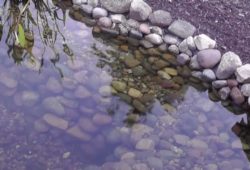Energy Efficient Pond Heaters Help Water Quality
In this article I’ll tell you about Energy Efficient Pond Heaters Help Water Quality. Do you really need a pond de-icer or heater this winter? While these might seem like an unnecessary purchase, if you have a small pond that is well-stocked with fish, an energy efficient pond heater or de-icer is a way to ensure that your fish stay alive in the winter.

Contents
Natural Pond Nutrient Cycles and Water Quality
In nature, leaves and detritus build up in the pond in the fall. Pond invertebrates chew on some of these leaves, while bacteria decompose others. Fish enjoy the bugs that fall off the leaves as well. In a larger, natural pond, fall leaves are just one more input into a working ecological system. Eventually, these leaves turn into mud at the bottom of the pond, or they become food for animals that are eaten by other animals in the pond food chain.
Koi Pond Nutrient Cycles and Water Quality
What happens in a small homemade pond? People tend to overstock their backyard ponds. These ponds have a lot of fish in them, and the fish are fed fish food, not bugs. This means that the pond can hold a lot more fish than it would in nature. In nature, any extra fish would simply die off when the food ran out or when the pond environment got overly cluttered with rotting leaves and fish feces. Consider the size of your fish pond and the number of fish you maintain to reduce your dependence on pond heaters and aerators.
The Need for Air Flow: Pond Holes, De-icers, and Heaters
As the evenings get cooler in the fall and winter, this dilemma becomes more of a concern. Pond fish can often survive the winter in a pond, but the pond must be healthy. A healthy pond has a good water pH, ammonia and oxygen level. If there is a lot of rotting vegetation, old fish food, and fish feces trapped in the pond for the winter and slowly decaying, this can compromise the water quality. One way to improve the water quality in the pond is to allow gases from decomposing organic matter to escape over the winter months.
Maintaining Air Flow in the Pond Without a Heater
In climates where it gets very icy, this means that you do not let the pond freeze over entirely. When the pond freezes over, this traps gases below the ice surface. Instead, you can try low tech ways of keeping the pond open, like physically maintaining an open space using frequent applications of hot water if the pond does not freeze that much. In climates that freeze very little, your existing pond aerator may be enough to keep a hole in the ice using its bubbles.
Choosing an Energy Efficient Pond Heater
One of the most time and energy efficient ways to keep a pond air hole open in the winter is to invest in an energy efficient pond heater. A simple foam pond vent de-icer uses as little as 6 watts of power. These heaters keep the water open in a ring around the de-icer, allowing gases to escape. They are good to about -20 degrees Celsius. In very cold climates, devices like the PondMaster 120 Watt heater will help keep a hole in the ice. This sort of heater or de-icer has a vent in the middle to release gases.
Maintaining a healthy pond in the winter months will allow you to have a thriving fish population into the spring. One way to do this is by installing a small, energy-efficient pond heater or de-icer to maintain air flow in the pond.



